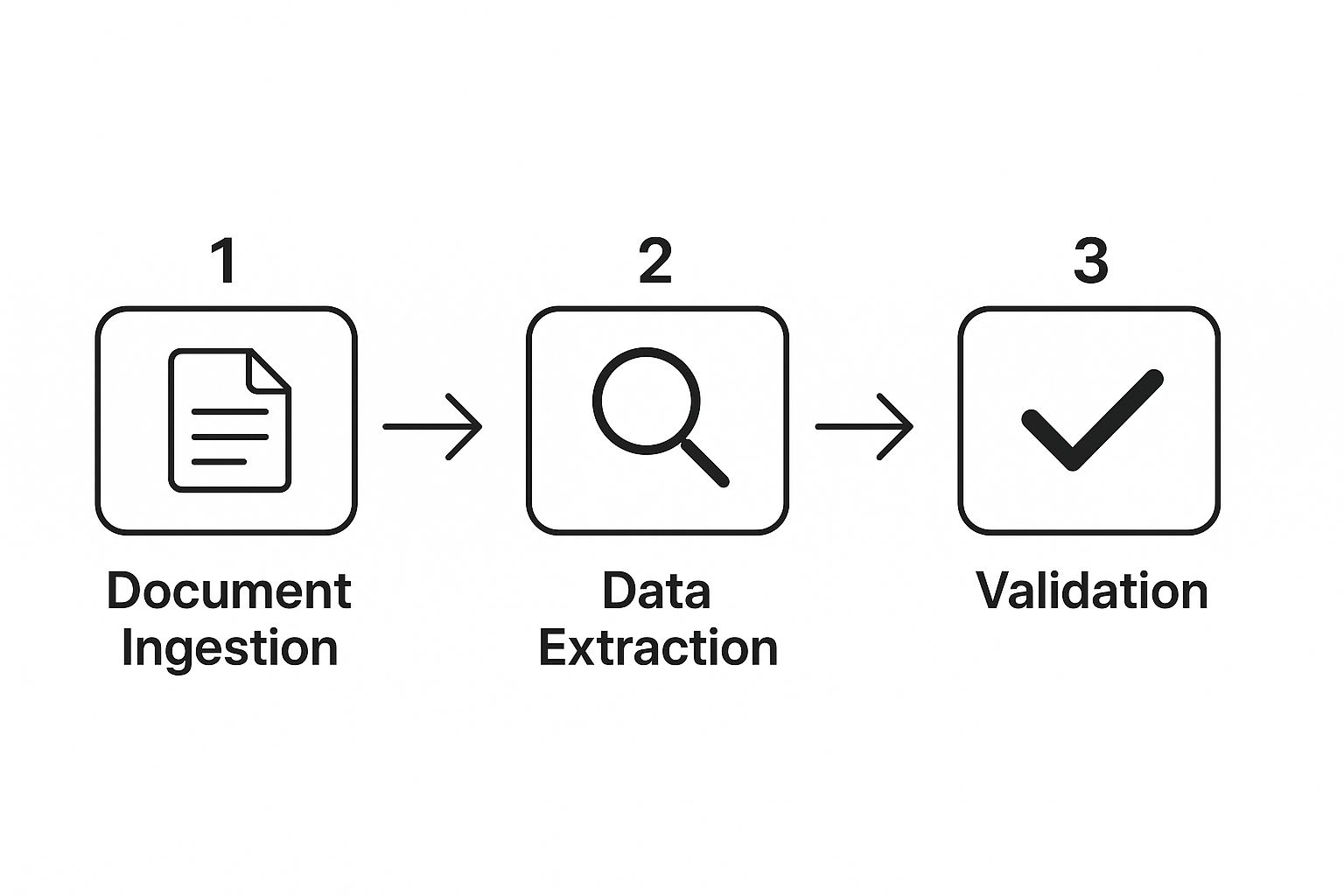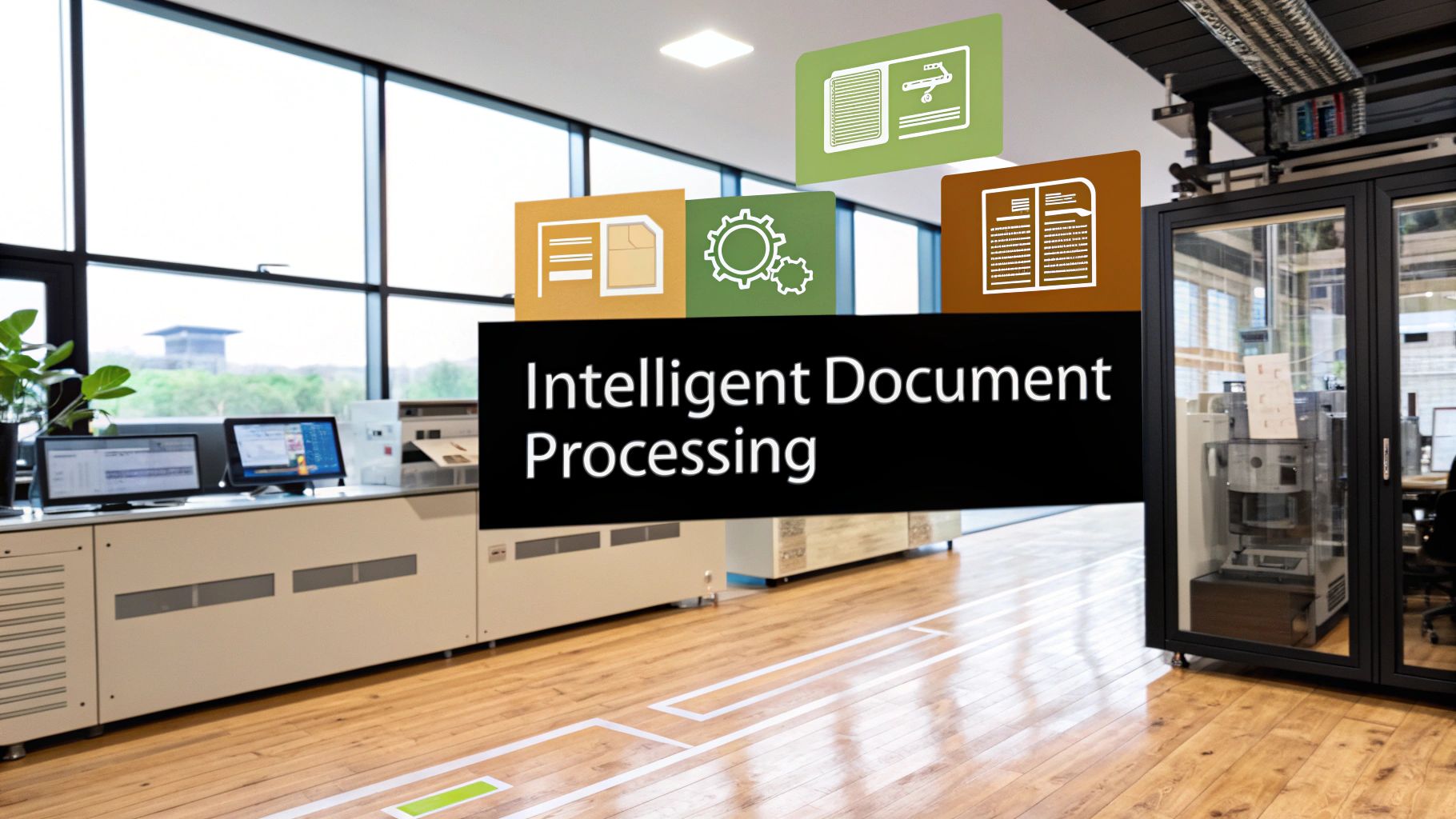What is Intelligent Document Processing? Unlock Business Efficiency
Intelligent Document Processing, or IDP, is a smart automation technology that does more than just scan documents—it actually reads and understands them. Think of it as a super-powered digital clerk. It takes all the messy, complicated information locked away in your invoices, contracts, and emails and transforms it into clean, organized data your business systems can actually use.
What Is Intelligent Document Processing, Really?

At its heart, IDP tackles a huge headache for nearly every business: the constant flood of unstructured information. Every day, companies are buried under a mountain of paperwork—supplier invoices, customer forms, legal agreements, you name it. For decades, the only way to get the useful bits of information out of these documents was to have someone sit there and type it all out by hand. It was slow, expensive, and mistakes were inevitable.
Taking a Big Leap Beyond Old-School Scanning
Early technologies like Optical Character Recognition (OCR) were a good first step. OCR is great at one thing: turning a picture of text into actual digital text. It digitizes the words on a page, but that’s where it stops. It has no real understanding. An OCR tool can read the numbers on an invoice, but it has no idea which number is the subtotal, which is the tax, and which is the final amount you need to pay.
This is exactly where IDP blows past the old methods. It doesn't just use OCR; it layers powerful AI technologies on top of it.
- Optical Character Recognition (OCR): This is the foundation—the "eyes" that scan and digitize the raw text from any document format.
- Machine Learning (ML): This is the "brain." It learns from experience, recognizing patterns in different document layouts and getting smarter and more accurate with every document it processes.
- Natural Language Processing (NLP): This is where the real "understanding" happens. NLP interprets the meaning and context behind the words, easily telling the difference between a billing address and a shipping address, for instance.
By adding a layer of intelligence over basic digitization, IDP doesn't just see data—it understands it. This is the key that unlocks true, end-to-end automation.
This powerful combination means an IDP system can handle the sheer variety and complexity of business documents you see in the real world. It can process neat, structured forms (like tax documents), semi-structured files (like invoices where the layout changes from one supplier to the next), and even completely unstructured text (like long contracts or email chains) with incredible accuracy. This ability to feed clean, verified data into other business systems is a cornerstone of modern workflow automation.
To really see the difference, it helps to compare IDP against the other common methods for handling documents.
Manual Processing vs OCR vs Intelligent Document Processing
Here’s a quick breakdown of how these three approaches stack up when it comes to performance.
| Feature | Manual Processing | Traditional OCR | Intelligent Document Processing (IDP) |
|---|---|---|---|
| Speed | Extremely slow, depends on human capacity | Fast for digitization, slow for extraction | Nearly instantaneous and highly scalable |
| Accuracy | Prone to human error (typos, misinterpretation) | High for character recognition, low for context | Up to 99% accuracy by understanding context |
| Data Type | Handles all types, but inefficiently | Limited to structured or templated documents | Excels with structured, semi-structured, and unstructured data |
| Scalability | Not scalable; requires more people | Moderately scalable for scanning, not for processing | Highly scalable to handle massive document volumes |
| Cost | High labor and operational costs | Moderate software cost, high manual verification cost | Lower total cost through reduced labor and errors |
As you can see, IDP isn't just a small improvement; it represents a fundamental shift in how businesses can manage information. It closes the gap between the messy, real world of documents and the structured, digital world of data.
How Intelligent Document Processing Works
https://www.youtube.com/embed/KVZ3b4e_C7k
To really get what Intelligent Document Processing is all about, you have to look under the hood. While the tech behind it is pretty complex, the actual workflow is a logical, step-by-step process. It’s built to turn a messy document into clean, usable data.
Think of it like a digital assembly line for information.
A document—whether it’s a scanned invoice, a PDF contract, or a photo of a receipt snapped on a phone—goes in one end. After a series of intelligent steps, it comes out the other side as perfectly structured data, ready to plug into your other business systems. Each stage adds another layer of refinement.
Stage 1: Document Pre-Processing and Ingestion
The journey starts the second a document arrives. IDP platforms are built to grab documents from just about anywhere: email inboxes, network scanners, mobile uploads, or cloud folders like Dropbox or Google Drive. This first step is all about getting the document ready for analysis.
The system runs a series of cleanup tasks to make sure the document is in the best possible shape. This often includes:
- Image Enhancement: Automatically straightening skewed pages, removing shadows or dark spots, and tweaking the brightness and contrast.
- Noise Reduction: Getting rid of any background speckles or digital artifacts that could confuse the software.
- Document Separation: If you scan a big batch of invoices as a single PDF, the system is smart enough to recognize where one ends and the next begins, splitting them into individual files.
This prep stage is absolutely crucial. A clean, high-quality image is the foundation for everything that follows.
Stage 2: Classification and Sorting
Once the document is cleaned up, the IDP system has to figure out what it's looking at. Is it an invoice? A purchase order? A legal agreement? This is document classification, and it's where the "intelligent" part really kicks in.
Using Natural Language Processing (NLP) and machine learning, the system analyzes the document’s layout, keywords, and overall structure. It’s looking for clues, much like a person would. For example, seeing phrases like "Invoice Number" and "Amount Due" is a dead giveaway that it's dealing with an invoice.
By automatically sorting documents, IDP ensures the right set of rules and extraction logic is applied to the right document type. This dramatically boosts accuracy and keeps the whole process flowing smoothly.
This means you can throw a mixed pile of documents at the system and trust it to sort them into the correct digital stacks, all without a person lifting a finger.
The visual below breaks down the core stages of the IDP workflow, from the initial intake to the final data check.

As you can see, each step builds on the last one, systematically turning a raw file into validated, structured information.
Stage 3: Intelligent Data Extraction
With the document identified and prepped, it's time for the main event: data extraction. This is where the real value is created. Unlike older OCR tools that just dump all the text from a page, IDP zeroes in on the specific bits of information you actually need.
The system uses AI models that have been trained on thousands of similar documents to pinpoint and pull out key data fields. For a typical invoice, that would be things like:
- Vendor Name
- Invoice Date
- Purchase Order Number
- Line Items and their quantities
- Subtotal, Tax, and Grand Total
The technology is advanced enough to find this data even when the layout is completely different from one invoice to the next. It understands the context, knowing that "Amount" and "Total Due" refer to the same concept.
Stage 4: Validation and Human-in-the-Loop Review
The final stage is all about quality control. The extracted data is automatically validated against business rules you’ve set up. For instance, the system can check that the sum of the line items actually adds up to the subtotal, or it can cross-reference a PO number against your accounting software to make sure it’s valid.
If the system isn't completely confident about a piece of data—maybe a smudge on the paper or some messy handwriting made it hard to read—it flags the field for a person to check. This "human-in-the-loop" process is what makes IDP so reliable. An employee can quickly glance at the flagged data, make a quick correction if needed, and approve it.
Best of all, this isn't just a one-off fix. Every correction is fed back into the machine learning model. This feedback loop helps the system get smarter and more accurate over time, so it needs less and less human help with every document it processes.
The Core Technologies That Power IDP

Intelligent Document Processing might seem like magic, but it’s actually a clever combination of several powerful technologies working together. Think of it like a highly skilled team where each member has a specific job, and their collaboration turns messy documents into clean, useful data.
The whole process starts with Optical Character Recognition (OCR). This is the foundation—the team's 'eyes'. OCR’s job is straightforward: it looks at an image of a document, like a scan or a photo, and translates the text it sees into digital characters a computer can read. It’s the essential first step that gets the words off the page and into the system.
But OCR alone is pretty limited. It can read the text, but it has no idea what any of it means. It sees "123-456-7890" but doesn't know it's a phone number. That’s where the real "intelligence" in IDP comes in, with other technologies adding layers of understanding.
Computer Vision: Seeing More Than Just Words
The first layer of smarts comes from Computer Vision, a branch of AI that teaches computers to make sense of the visual world. In IDP, this goes way beyond just recognizing letters. Computer Vision analyzes the document’s entire layout—spotting things like tables, columns, logos, signatures, and form fields.
This is absolutely critical for documents like invoices, where key information can be all over the place. For instance, Computer Vision can identify a table of line items just by its structure, even without perfect grid lines. It gives the system a roadmap of the document before it even starts digging into the text.
Natural Language Processing: Understanding the Meaning
Once OCR has the text and Computer Vision has mapped the layout, Natural Language Processing (NLP) steps in to act as the 'brain'. NLP is all about understanding the context and intent behind the words themselves.
This is how an IDP system can look at two addresses on a purchase order and correctly identify one as the ‘Billing Address’ and the other as the ‘Shipping Address’. It does this by picking up on contextual clues from the surrounding words, just like a person would. NLP is the powerhouse that deciphers language, making sense of complex sentences and industry-specific terms.
By combining these technologies, IDP systems can process documents with a level of accuracy and flexibility that was previously impossible. This capability is driving huge demand for automation solutions across all sectors.
The market certainly reflects this. Valued at around USD 2.45 billion in 2024, the global IDP market is projected to explode to USD 46.23 billion by 2033. That’s an impressive annual growth rate of 35.20%. You can discover more insights about the IDP market growth and what's driving it. This boom shows just how much businesses are moving beyond simple scanning to truly intelligent data extraction.
Machine Learning: Getting Smarter Over Time
The final piece of the puzzle is Machine Learning (ML). This is what allows an IDP system to learn from its experiences and get better with every document it handles.
When a person corrects a piece of extracted data, that feedback is fed back into the AI model. This creates a continuous learning loop, making the system more accurate as it goes. It learns to recognize new document layouts, adapt to variations, and ultimately requires less human oversight. ML turns IDP from a static tool into a dynamic, evolving solution that gets better the more you use it.
The Real-World Payoff: What IDP Actually Does for Your Business
While the technology powering Intelligent Document Processing is fascinating, what really matters are the tangible, bottom-line results it brings. Adopting IDP isn't just about going paperless; it’s a strategic decision that fundamentally changes how your business operates for the better. The benefits create a ripple effect, touching everything from back-office operations to the way you interact with customers.
At its heart, IDP is about two things: efficiency and accuracy. When you swap out slow, mistake-prone manual data entry for a smart, automated system, you see immediate and powerful gains. This makes your whole organization faster, leaner, and more competitive.
Slash Your Operational Costs
One of the first things you'll notice is a significant drop in operational expenses. Processing documents by hand is a massive time-sink. Just think about the hours your team spends typing up invoice details, double-checking customer forms, or sifting through contracts. Every single one of those hours has a direct cost attached to it.
IDP automates the lion's share of that work. A single platform can churn through a volume of documents that would normally demand a whole team of people. The financial impact is clear:
- Lower Labor Costs: You simply don't need as many people tied up in repetitive data entry and verification.
- Fewer Costly Errors: By virtually eliminating human error, you avoid expensive mistakes like overpaying a vendor, facing compliance penalties, or sending a shipment to the wrong place.
- Faster Cash Flow: Invoices get processed and paid quicker, which can unlock early payment discounts. Customers are onboarded faster, meaning you start generating revenue sooner.
By automating document-heavy tasks, companies can shift money and talent away from tedious operational chores and toward initiatives that actually grow the business. It turns a cost center into a value creator.
Radically Improve Data Accuracy and Compliance
Let's be honest—human error is a fact of life in any manual process. No matter how meticulous your team is, typos, transposed numbers, and misinterpreted fields are bound to happen. These seemingly small mistakes can snowball into big problems, causing flawed financial reports, bad business decisions, and serious compliance risks.
IDP systems combine AI technologies to read and understand documents with near-perfect accuracy. The system's built-in validation rules and self-learning capabilities ensure the data it captures is not just correct, but clean and reliable from the get-go. This is a game-changer for maintaining compliance and making decisions based on solid information.
Put Critical Business Processes in the Fast Lane
In today's market, speed is everything. A delay in approving a loan, processing an insurance claim, or onboarding a new partner can mean losing a customer or falling behind the competition. More often than not, these delays are caused by a document bottleneck—a stack of paperwork sitting in someone's inbox, waiting for manual review.
One of the biggest wins with IDP is how it fuels workflow automation and frees up your team's time. An IDP solution works 24/7, processing documents in minutes instead of hours or days. This acceleration completely transforms key business functions. For more on this, check out our guide on how to improve operational efficiency.
Give Your Team a Morale and Productivity Boost
This last benefit is often overlooked, but it's huge: the positive impact on your employees. Nobody gets excited about spending their day doing mind-numbing, repetitive data entry. It’s draining work that leads to boredom, burnout, and high turnover.
By automating these routine tasks, IDP frees your team from the drudgery. Instead of just keying in data, they can focus on work that requires their actual brainpower—like problem-solving, strategic analysis, and building customer relationships. An accounts payable clerk can go from typing up invoices to analyzing spending trends. This not only boosts morale and job satisfaction but turns your team into a more powerful, strategic asset.
Real-World Applications and Use Cases

The technology driving Intelligent Document Processing is impressive, but its real magic comes to life when you see it solving actual business problems. IDP isn't just a concept for tech enthusiasts; it’s a hands-on tool that gets real results in just about every industry out there.
Across the board, from finance to healthcare, companies are using IDP to get out from under the weight of manual, document-heavy tasks. These examples show how turning messy, unstructured information into clean, structured data can completely change the game for speed, accuracy, and customer happiness.
Transforming Finance and Banking Operations
The entire financial world runs on paperwork, which makes it prime territory for IDP. Just think about the mortgage application process. A single loan package is a mountain of documents—tax returns, pay stubs, bank statements, and IDs. Processing all of that by hand can take hours, sometimes days, and those delays are exactly what frustrates customers.
Now, imagine a bank using IDP to handle that workflow. The system takes in all the documents, figures out what each one is, and pulls out the crucial data—like income, account balances, and addresses—all within minutes. This gives loan officers the information they need to make decisions faster and gives buyers a much smoother ride.
This kind of automation is also popping up in other key areas:
- Invoice Processing: Automatically pulling data from thousands of vendor invoices to speed up payments and snag early payment discounts.
- Know Your Customer (KYC): Confirming customer identities in a snap by extracting and validating information from driver's licenses and passports.
- Trade Finance: Handling complex paperwork like bills of lading and letters of credit to keep global trade moving.
Modernizing Healthcare Administration
Healthcare is another industry practically drowning in documents, from patient intake forms to bafflingly complex insurance claims. All this administrative work eats up time that doctors and nurses could be spending with patients. IDP is a powerful way to lift that burden and improve the quality of care.
Picture a hospital's front desk. Instead of someone manually typing everything in, IDP can automatically grab information from insurance cards and patient history forms, then feed it directly into the hospital's electronic health record (EHR) system. This makes check-in a breeze and, more importantly, cuts down on the data entry mistakes that can affect patient safety.
When it's time to bill, the same system can process insurance claims, explanation of benefits (EOB) documents, and payments with incredible accuracy. This helps providers get paid faster, reduce denied claims, and maintain their financial health.
By handling the administrative load, intelligent document processing allows healthcare professionals to focus on their primary mission of patient care, leading to better outcomes and a more efficient system.
Streamlining Human Resources and Recruitment
Every company’s HR department is constantly juggling resumes, applications, and onboarding documents. A classic example of IDP in HR is the widespread use of Applicant Tracking Systems (ATS). An IDP-powered ATS can instantly scan hundreds of resumes, pull out key details like skills, experience, and education, and automatically match the right candidates to open positions.
This saves recruiters a massive amount of time they would have spent on manual screening, letting them focus their energy on talking to the most promising people. You can get a better sense of how this works by looking into the top https://makeautomation.co/10-business-process-automation-benefits-2024/ that businesses are seeing today.
Even the public sector is getting on board. The U.S. Department of Defense, for example, is using IDP to process military contracts more efficiently. Meanwhile, the UK’s National Health Service has automated parts of its patient record management to boost accuracy and prevent medical errors. These examples show just how essential IDP has become in critical sectors.
How to Choose the Right IDP Solution
Picking an Intelligent Document Processing solution isn't as simple as choosing software off a shelf. The right platform can become a massive competitive advantage, but the wrong one will just lead to headaches and a wasted budget. Making the right call comes down to having a clear framework for weighing your options against what your company actually needs.
First things first: look at the documents you work with every single day. A solution that’s a rockstar at processing neat, structured tax forms might completely fall apart when faced with the chaotic world of semi-structured invoices from a thousand different vendors.
Here's a pro tip: when you get a demo, insist on using your documents—the messy, real-world ones. Don't let vendors show you their perfectly curated examples. It’s the only way to get a true feel for its accuracy and how it will perform in your environment.
Assess Core Technical Capabilities
Once you’ve thought about your documents, it’s time to get under the hood and look at the technical features. These capabilities will ultimately decide how well the solution integrates into your daily operations and how much value you get from it.
Drill down into these key areas:
- Integration Power: How well does it play with others? You need a platform that can seamlessly connect to the systems you already rely on, like your CRM, ERP, or accounting software. Look for pre-built connectors that make this process plug-and-play.
- Deployment Model: Do you want a cloud-based (SaaS) tool for its flexibility and lower upfront IT lift, or do you need an on-premise installation for absolute control over your data? Each has its own set of trade-offs regarding cost, security, and maintenance.
- Scalability: Think about the future. The platform needs to handle not just today's document volume but also the much larger loads you expect as your business grows.
Evaluate Vendor Support and Training
Even the most advanced technology is worthless if you don't have good people backing it up. The vendor you choose is more than just a software provider; they're a long-term partner. The quality of their support and training is just as critical as the software itself.
When you’re talking to vendors, ask the tough questions about their support. Is training included? What does the onboarding process really look like? A great partner provides clear documentation, hands-on training, and responsive support to get your team comfortable and help you solve problems when they inevitably pop up.
A great IDP vendor acts as a true partner, invested in helping you achieve your automation goals. Their support and training are direct reflections of their commitment to your success.
Choosing the right partner is a big decision, and it pays to be methodical. The table below provides a solid checklist you can use to compare different IDP providers and find the one that truly fits your needs.
Criteria For Selecting An IDP Solution
| Evaluation Criteria | What to Look For | Why It Matters |
|---|---|---|
| Document Handling | Accuracy rates for your specific document types (invoices, contracts, etc.). Support for structured, semi-structured, and unstructured formats. | Ensures the solution can reliably process the documents that are central to your business operations. |
| Integration | Pre-built connectors for your key software (CRM, ERP). A robust API for custom integrations. | Prevents data silos and ensures seamless automation across your entire tech stack. |
| Deployment Options | Availability of cloud (SaaS) or on-premise models. | Allows you to choose the model that best fits your security, budget, and IT infrastructure requirements. |
| Vendor Support | Clear onboarding process, accessible technical support, and comprehensive training resources. | Guarantees you can get the help you need to maximize your ROI and resolve issues quickly. |
By carefully considering each of these points, you move beyond the marketing hype and can make an informed decision based on the technical capabilities and vendor partnership that will drive real results for your business.
Common IDP Questions, Answered
As you dig into Intelligent Document Processing, a few questions always pop up. Getting straight answers to these helps separate the hype from the reality and shows you how IDP is different from older tech you might already use. Let's clear up the most common ones.
What's the Difference Between IDP and OCR?
This is easily the most frequent—and most important—question. The distinction is actually quite simple when you think about it.
Optical Character Recognition (OCR) is just the first step. It’s a technology that scans a document and turns the letters and numbers into text a computer can read. Think of it like a photocopier for data—it digitizes the text, but it has no idea what any of it means.
Intelligent Document Processing (IDP) picks up where OCR leaves off. It uses that digitized text and applies layers of AI, like machine learning and natural language processing, to actually understand the document's content and context.
An OCR tool looks at an invoice and gives you back a block of text. An IDP solution looks at the same invoice and tells you, "This is from ACME Corp, the total is $1,547.22, and it's due on October 31st."
It doesn't just read the words; it comprehends their purpose and extracts them as structured, usable data ready for your other systems.
How Long Does It Take to Implement an IDP Solution?
This isn't a six-month, all-hands-on-deck project anymore. For common documents like invoices, purchase orders, or receipts, modern cloud-based IDP platforms can be up and running in a matter of weeks.
The typical process looks something like this:
- Connect your document sources, whether that’s an email inbox, a shared drive, or a cloud storage folder.
- Fine-tune pre-trained models to recognize the specific fields on your documents.
- Integrate the structured output with your target systems, like an ERP, CRM, or accounting software.
Of course, if you're dealing with highly customized or unusual documents, the AI might need a bit more training, which could extend the timeline. But for most businesses, the setup is surprisingly fast.
Can IDP Handle Handwritten Documents?
Yes, and this is where IDP really shines compared to older tech. Modern IDP systems use sophisticated computer vision and AI models trained on millions of examples of handwriting. The result is a system that can read and interpret messy, varied handwriting with a high degree of accuracy.
While it's true that the accuracy for perfectly typed text will always be a bit higher, today's IDP can reliably pull key information from handwritten forms, customer notes, and signed delivery slips. This is a massive breakthrough for industries like healthcare, insurance, and logistics, where handwritten documents are still a daily reality.
Ready to stop wrestling with manual data entry and give your team the freedom to focus on more valuable work? MakeAutomation specializes in building AI-powered automation that removes operational headaches and helps you scale. See how we can design a custom IDP solution for your business at https://makeautomation.co.







